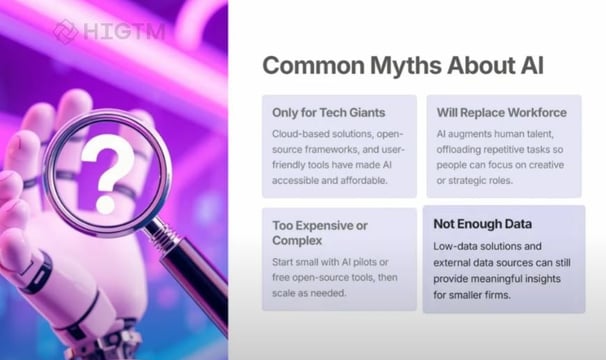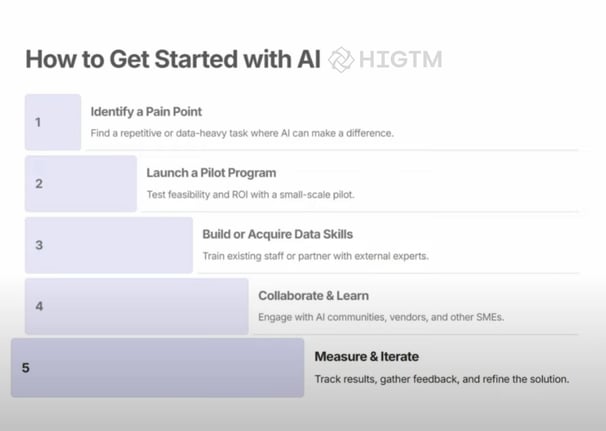1. What Is AI? A High-Level Guide and Its Relevance to SMEs
Artificial Intelligence (AI) no longer belongs only to tech giants or science fiction. In recent years, small and medium-sized enterprises (SMEs) have increasingly discovered that AI can tackle everyday challenges—such as automating repetitive tasks, predicting market demand, or improving customer interactions. Yet many SMEs still wonder, “What is AI, really? And why should we care?” This post offers a high-level definition of AI, dispels common myths, and highlights the practical benefits it can bring to businesses that lack the massive resources of large corporations. By the end, you’ll see how AI, with all its subfields and innovative techniques, can become a critical ally for SMEs seeking efficiency, agility, and long-term growth.
Q1: FOUNDATIONS OF AI IN SME MANAGEMENT - CHAPTER 1 (DAYS 1–31): CORE AI CONCEPTS & VALUE PROPOSITION
Gary Stoyanov PhD
1/1/20257 min read

1. Defining AI: More Than a Buzzword
1.1 AI Mimics Human Intelligence
At its core, Artificial Intelligence involves machines mimicking or approximating certain aspects of human intelligence—such as learning, reasoning, pattern recognition, and self-correction. In a practical sense, AI algorithms can consume historical data, glean insights, and apply those insights to make predictions, categorize incoming information, or even carry out tasks autonomously. The flexibility of AI means it can adapt and get “smarter” over time—often learning from mistakes to improve future results.
1.2 Subfields of AI
Machine Learning (ML): This subfield relies on statistical methods to help machines learn from data without being explicitly programmed. Once trained, an ML model can predict, classify, or cluster new information.
Deep Learning: A specialized branch of machine learning that uses multi-layered neural networks, often delivering impressive performance in complex tasks like image recognition or language translation.
Natural Language Processing (NLP): Focuses on how computers interpret, understand, and generate human language. Chatbots, sentiment analysis, and language translation tools use NLP.
Computer Vision: Allows machines to interpret visual data—detecting objects, recognizing faces, or analyzing images for insights.
In the past, these areas might have seemed too technical or niche for smaller businesses. Today, cloud-based tools, user-friendly interfaces, and open-source frameworks have drastically lowered barriers to entry, making these advanced capabilities accessible to organizations with limited budgets and staff.
2. Common Myths About AI
2.1 “AI is Only for Tech Giants”
A decade ago, building AI solutions may have required specialized hardware, highly trained data scientists, and enormous data sets. But the technological landscape has changed dramatically. Many AI service providers offer pay-as-you-go cloud solutions, allowing SMEs to experiment with minimal risk. Meanwhile, open-source libraries like TensorFlow or PyTorch make it possible to start small and scale as needed.
2.2 “AI Will Replace My Workforce”
Fears of robots taking over entire job functions often overshadow AI’s practical reality. Most AI implementations augment, rather than replace, human employees. Yes, certain repetitive tasks—such as manual data entry—are prime candidates for automation. However, people are still needed to handle strategic decisions, customer relationships, creative thinking, and tasks requiring emotional intelligence. AI’s real power lies in freeing teams from mundane chores so they can devote time to higher-level responsibilities.
2.3 “AI is Too Expensive or Complex for My Company”
While advanced AI projects can certainly cost a fortune, many SMEs see immediate value from smaller-scale efforts. The rise of free open-source libraries, accessible “low-code” platforms, and managed AI services with transparent pricing means you can start with a modest pilot budget. Additionally, plenty of consultancies and online communities can provide specialized knowledge, lowering the complexity for a resource-constrained organization.
2.4 “We Don’t Have Enough Data for AI”
Yes, more data often leads to better model performance—but “data scarcity” doesn’t always bar you from AI. Some AI techniques, such as few-shot learning or data augmentation, are specifically designed for limited data environments. Plus, external data sets (e.g., public databases or partner-shared data) and synthetic data can fill in gaps. In truth, SMEs can achieve meaningful results even with smaller data sets if the project scope is well defined.
3. Why AI Matters for SMEs
AI may initially sound lofty, but it brings real, tangible advantages that can propel smaller businesses:
Efficiency Gains
By automating routine tasks—like scheduling, data entry, or simple customer queries—AI helps staff focus on more strategic roles.
Examples include customer support chatbots handling repetitive FAQs, or automated invoice processing tools that cut administrative hours.
Cost Savings
Well-deployed AI can reduce overhead by streamlining everything from inventory control to supply chain logistics.
Predictive tools that forecast maintenance issues can help avoid costly machine breakdowns, especially for manufacturing SMEs.
Growth & Innovation
AI can reveal hidden trends in sales data, offering new product ideas or identifying untapped market segments.
By personalizing customer experiences (like recommending relevant items or offering dynamic pricing), businesses can attract and retain clientele more effectively.
Strategic Agility
AI models can function as early-warning systems, spotting shifts in consumer behavior or production anomalies before they escalate.
SMEs, known for their agility, can pivot faster than large enterprises, capitalizing on AI-driven insights quickly.
4. Real-World Scenarios
4.1 Retail & E-Commerce
Inventory Optimization: An AI system monitors stock levels in real time, predicting which items need restocking soon. This cuts inventory holding costs while avoiding out-of-stock frustrations for customers.
Personalized Recommendations: Recommender engines can show shoppers products based on browsing or purchase histories, boosting average order values.
4.2 Manufacturing & Supply Chain
Predictive Maintenance: Attached sensors and AI models analyze machinery performance. They alert teams to replace parts before failure, reducing costly downtime.
Quality Control: Computer vision systems scan products for defects, improving consistency and lowering waste rates.
4.3 Hospitality & Tourism
Dynamic Pricing: Hotel room rates or travel package prices can be adjusted according to demand, season, and competitor pricing. AI calculations maximize revenue while remaining competitive.
Guest Personalization: AI-based recommendation engines might suggest local attractions or services based on the guest’s profile or past travel behaviors.
These examples highlight the variety of AI applications. Many smaller organizations have already implemented these solutions, often discovering that AI works as a flexible tool for solving specific, real-world problems.
5. How to Get Started with AI
5.1 Identify a Concrete Pain Point
Don’t try to “do AI” everywhere at once. Pick a specific area—such as frequent customer queries, time-consuming data entry, or inventory mismanagement—where you suspect automation or predictive insights could make an immediate difference. Focused pilots yield clearer ROI metrics.
5.2 Launch a Pilot Program
Begin with a small-scale project that tackles this identified problem. Such pilots can be done with minimal budget by leveraging open-source software or short-term cloud subscriptions. The goal is to confirm feasibility and measure success metrics (e.g., time saved, error reduction, or revenue uptick).
5.3 Build or Acquire Data Skills
Upskill Existing Staff: Offer courses or training for employees who show interest in data analytics or machine learning.
Partner with External Experts: Consultants or agencies can guide the initial phases, speeding up adoption.
Community & Workshops: Many local or online communities host AI meetups and workshops tailored for beginners, providing free or affordable learning opportunities.
5.4 Collaborate & Learn
AI adoption is a moving target, with technologies evolving rapidly. Maintaining a collaborative mindset—where you exchange insights with other SMEs, technology vendors, or academic institutions—keeps you up to date on the newest methods, tools, and success stories.
5.5 Measure & Iterate
Collecting metrics is vital to gauge the success of your pilot. Decide on key performance indicators (KPIs)—like faster response times, reduced overhead, or higher conversion rates—and evaluate them regularly. Use these insights to refine your model, scale up, or pivot to a different solution.
6. A Holistic Approach: HIGTM’s Perspective
6.1 Holistic Assessments
At HIGTM, we believe in analyzing not just the technical feasibility of an AI system but also its alignment with your business model, culture, and customer needs. This ensures that AI becomes a natural extension of your workflow rather than a forced add-on.
6.2 Tailored Solutions
No two SMEs share identical challenges or resources. By customizing AI tools to each organization’s specific needs, we help avoid the pitfalls of generic, one-size-fits-all solutions. This might mean picking the right data collection strategy, adopting the most suitable cloud platform, or implementing a targeted software pilot.
6.3 Scalable Implementation
We encourage SMEs to start small but think big—to pilot AI solutions, document best practices, and then replicate successes across other departments. This “crawl, walk, run” approach mitigates risk and gradually builds internal expertise.
6.4 Ethical & Sustainable AI
Data handling, regulatory compliance, and user privacy aren’t afterthoughts. They’re integral from day one. By embracing ethical AI—respecting privacy and avoiding bias—you foster trust among employees, partners, and customers. Additionally, focusing on sustainability ensures that short-term wins don’t overshadow long-term stability.
7. Key Takeaways
7.1 AI is Accessible
Accessible AI solutions exist even for businesses with limited budgets or tech talent. Start with cloud-based or open-source tools, and expand as you validate ROI.
7.2 Start Small, Think Big
Tackling an entire business transformation overnight can be overwhelming and costly. A small pilot project (like a single chatbot or a simple predictive maintenance model) can showcase tangible benefits, leading to broader adoption down the line.
7.3 Culture & Readiness Matter
Introducing AI is partly about technology, but it’s also about organizational culture. Employees need to understand and embrace changes. Regular communication, training, and leadership support pave the way for smooth adoption.
7.4 Competitive Edge
AI is no longer optional in many sectors. As more competitors tap into advanced data analytics or automation, standing still poses a risk. Even small enhancements—a few hours saved per week or a bump in sales conversions—can differentiate an SME in a crowded market.
7.5 Continuous Learning
Because AI technologies evolve rapidly, staying informed is essential. Keep tabs on industry trends, consider advanced features (like deeper NLP or sophisticated recommendation engines), and remain open to ongoing improvement.
8. Conclusion: AI for Sustainable Growth
Far from the hype-laden concept it once was, AI now serves as a practical tool that SMEs can harness for tangible, real-world benefits—whether that’s reducing costs, driving innovation, enhancing customer engagement, or building a more agile business model. By grasping the fundamentals of AI, dispelling common misconceptions, and starting with well-defined pilot projects, your organization can lay a strong foundation for sustainable growth.
At HIGTM, our mission is to guide SMEs step by step—ensuring AI adoption is both purposeful and flexible.
The key is to align AI solutions with your day-to-day operations and strategic goals, so the technology truly amplifies your strengths. Embrace an attitude of continuous learning, involve your team, and remember that small, incremental AI wins can add up to significant transformations over time.
If you have more questions—about getting started, managing costs, or integrating AI ethically—don’t hesitate to reach out.
Whether you’re exploring a pilot chatbot or aiming to embed machine learning across your business processes, the potential for improved efficiency and competitive edge is well within your grasp.
With the right strategy, even the leanest SME can leverage AI as a partner for sustainable growth and meaningful innovation.




Turn AI into ROI — Win Faster with HIGTM.
Consult with us to discuss how to manage and grow your business operations with AI.
© 2025 HIGTM. All rights reserved.
